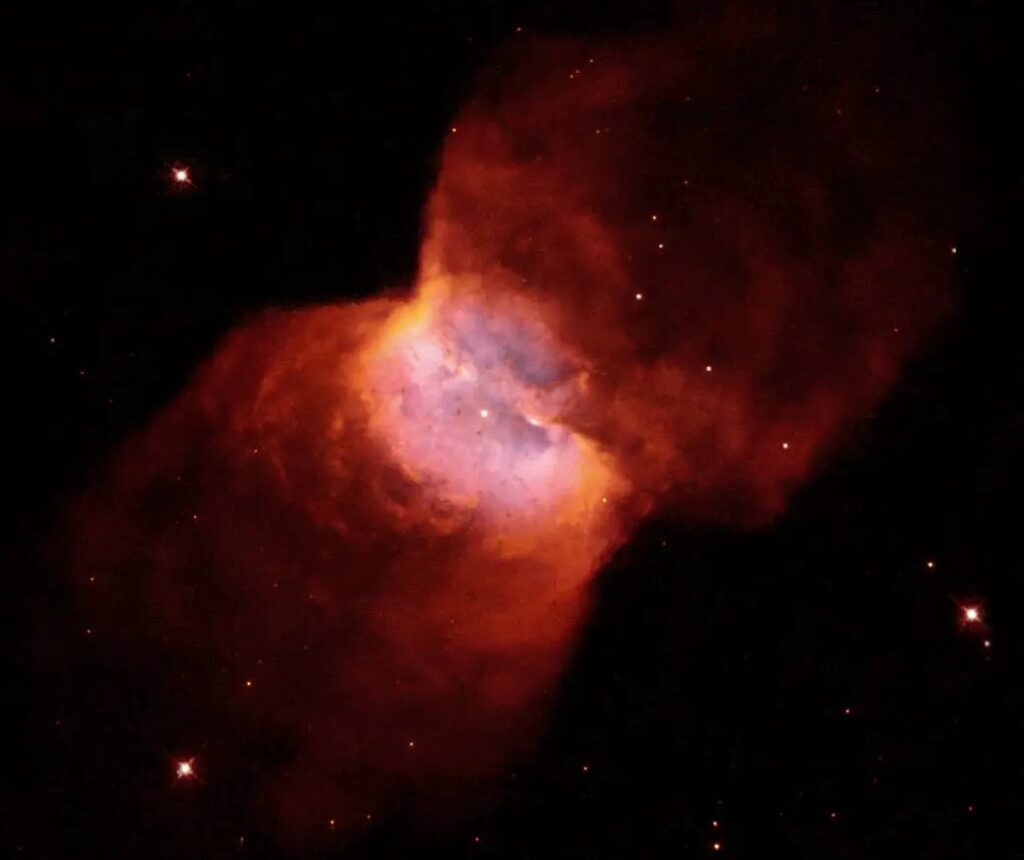The Butterfly Nebula, also known as NGC 2346, is a planetary nebula located in the constellation Monoceros, approximately 2,000 light-years from Earth. Planetary nebulae are formed when a dying star sheds its outer layers, creating a shell of ionized gas and dust. It was discovered by the German-born British astronomer William Herschel in 1785. Here’s some information about this astronomical object:
Physical Characteristics
At the centre of NGC 2346 lies a binary star system consisting of a white dwarf and a main-sequence star. The white dwarf is the remnant of the original star that has shed its outer layers to form the nebula. The remaining companion star is still in its main sequence phase, and its interaction with the white dwarf plays a role in shaping the nebula’s structure.
The nebula has a bipolar or hourglass shape, with two lobes extending from the central star. This shape is believed to be the result of the interaction between the stellar wind from the central star and the surrounding interstellar medium. The interaction with the binary companion star may also contribute to the unusual morphology of the nebula, influencing how the gas is ejected and distributed.
The nebula exhibits a variety of colours, including blue, green, and red, which are produced by different elements in the gas and dust cloud. Ionized oxygen produces the blue-green light, while hydrogen and nitrogen give off the characteristic red hues, particularly in the H-alpha emission. These colours offer clues about the chemical composition and physical conditions within the nebula.
Evolutionary Stage
NGC 2346 represents a relatively advanced stage in the evolution of a Sun-like star. The central star has exhausted its nuclear fuel and shed its outer layers, exposing its hot core as a white dwarf. The expelled gas and dust form the visible nebula, which will continue to expand into space until it eventually dissipates into the interstellar medium. This planetary nebula stage is relatively brief, lasting only a few tens of thousands of years.
Over time, the nebula will fade as its gas disperses, and the white dwarf will continue to cool and dim, transitioning into the final stages of stellar evolution.
Observation
The apparent magnitude of NGC 2346 typically falls within the range of 10 to 11, meaning it is faint and requires a telescope to observe, particularly due to its relatively small size. A moderate-sized telescope (8 inches or larger) under dark sky conditions will provide the best opportunity to view the nebula’s structure.
Monoceros, the constellation that hosts NGC 2346, is an equatorial constellation, meaning it straddles the celestial equator. As a result, it can be observed from both the Northern and Southern Hemispheres.
In the Northern Hemisphere, it is best viewed in the winter months, particularly December to February. In the Southern Hemisphere, it is also visible during the same months but appears slightly higher in the sky due to its position near the celestial equator.
To maximize your chances of seeing the nebula, observe it during clear, dark nights. Avoid nights with a bright moon, as its light can wash out the faint details of the nebula.



